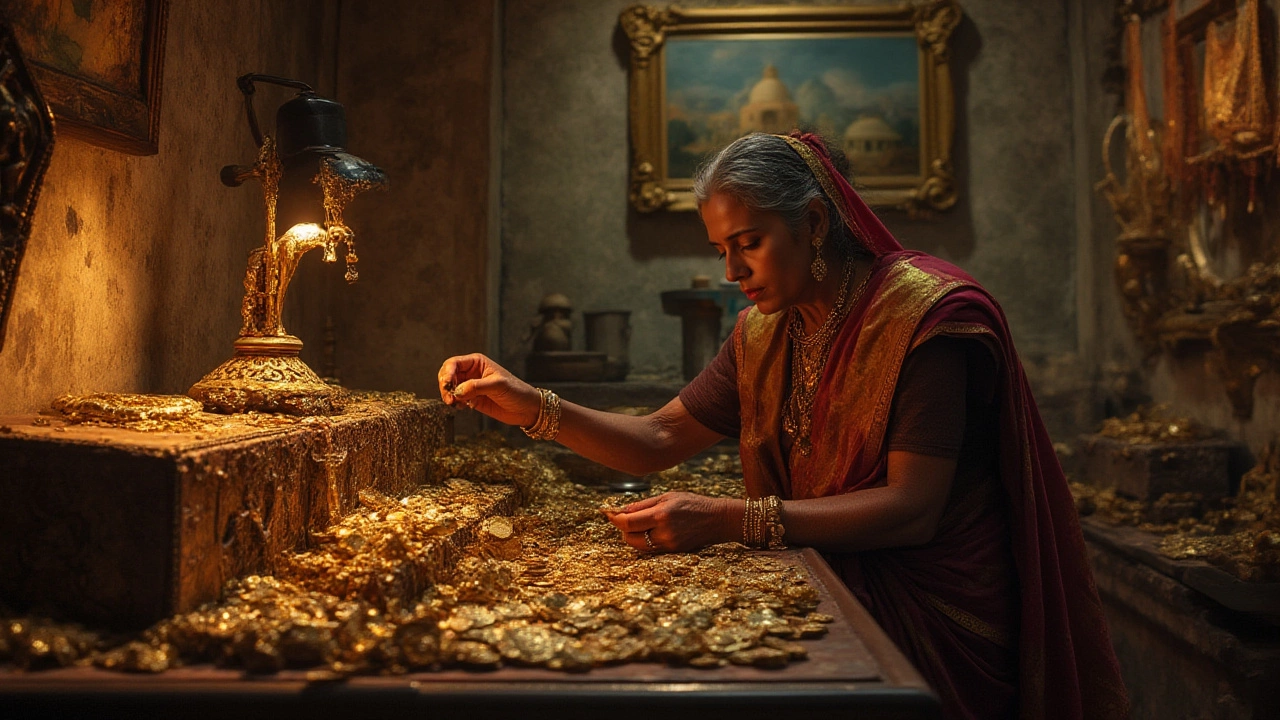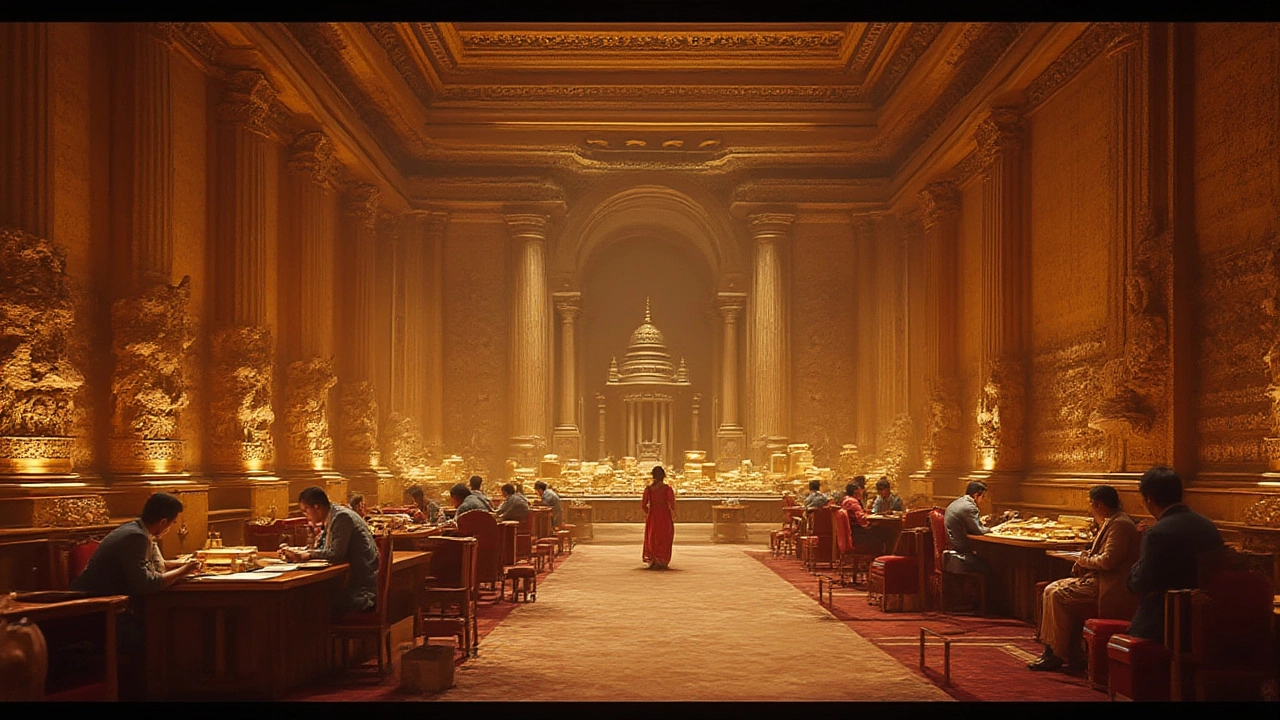There's something wildly captivating about gold. It glitters with the promise of power and fortune, triggering everything from epic treasure hunts to multi-billion-dollar vaults under the world’s capitals. If you’ve ever wondered who actually owns the most gold on the planet, you're not alone. The answer isn’t as simple as pointing to Fort Knox or picturing Scrooge McDuck’s vault. Gold ownership is a tangled mix of national stash, private bullion, secret underground storerooms, and even jewelry tucked in family safes. Let’s pull back that velvet curtain and see who’s really stockpiling the gold—and why it matters more than ever in 2025.
The World's Top Gold Hoarders: Central Banks and Nations
When you think about who owns the most gold, the first answer that usually springs to mind is: countries, via their central banks. That’s partly right—and the real drama happens here. Why do governments stack up so much gold? Because it acts like insurance in times of crisis. No matter what currencies do, gold holds value and can even rescue economies in a pinch. For decades, central banks have kept tight lips on their total gold reserves, but thanks to transparency rules, we now know quite a bit more.
Let’s put it plainly: by mid-2025, the United States is still king of the gold hill. According to the latest IMF data released in March 2025, America claims 8,133.5 metric tons—mostly sleeping quietly in Fort Knox, West Point, and the Denver Mint. That’s more than double the stash of Germany, which comes in second with 3,355.1 metric tons. Italy isn’t far behind, holding 2,451.8 metric tons, followed by France, Russia, and China. Here’s a look at the official ranking, straight from recent data:
| Country | Gold Reserves (Metric Tons, 2025) |
|---|---|
| United States | 8,133.5 |
| Germany | 3,355.1 |
| Italy | 2,451.8 |
| France | 2,437.5 |
| Russia | 2,331.7 |
| China | 2,192.4 |
| Switzerland | 1,040.0 |
| Japan | 845.8 |
| India | 801.0 |
| Netherlands | 612.5 |
Now, people like to joke that all the gold bars in Fort Knox could be chocolate for all we know—but the U.S. Treasury claims it’s all accounted for, with periodic audits and enormous security. Germany keeps much of its gold at home, but also stores chunks in London and New York for added flexibility and safety. Russia, in a move that kept economists buzzing over the past few years, has dumped lots of its U.S. dollars in favor of gold. By early 2025, over 23% of their central bank reserves were in gold.
China's stash is a special case. Their numbers have grown fast, but the real total is probably higher than what’s made public. Chinese gold buying is strategic—quiet, persistent, and aimed at reducing dependence on the U.S. dollar. India also deserves a mention, sitting at #9. Indians don’t just hold gold at an official level; private households there are obsessed with it, and we'll talk more about that soon.
Each nation’s numbers reflect decades of policy and planning. Some, like Switzerland, sold off piles of gold in the 2000s thinking it was old-fashioned—then watched prices skyrocket later. Others, such as Russia and China, did the opposite and reaped the rewards as gold’s value soared during times of crisis and inflation. All those bars aren’t just sitting pretty—they underpin global financial confidence.
Private Gold: Billionaires, Investors, and Hidden Treasures
If you thought vaults and central banks have the only game in town, think again. In fact, private gold ownership in jewelry, coins, and bars is massive—and rising. It’s not just the billionaire class or traditional gold bugs, either. Across the world, ordinary people (and a few secretive oligarchs) have been quietly stashing away a mountain of gold. Why? Two simple reasons: gold is portable wealth, and it’s the one asset that doesn’t need electricity, a bank account, or a government stamp to hold value.
It’s tricky—and maybe even impossible—to pinpoint the exact total of privately held gold. But studies by the World Gold Council estimate that, as of 2025, more than 48% of all gold ever mined is now in private hands, mostly in jewelry. That’s about 93,000 metric tons. Imagine the world’s largest sports stadium completely filled with gold—it would barely hold this treasure. The rest is split between official reserves, industrial use, and investments like ETFs or bullion bars in secure facilities.
So, who are the most notorious private gold owners? Let’s walk through a few names and fascinating tales:
- John Paulson: The legendary hedge fund manager, who famously bet against the housing bubble, shifted billions into gold after 2008. At his peak, Paulson’s funds reportedly owned more than $4.6 billion in gold.
- Ray Dalio: The founder of Bridgewater Associates has spoken publicly about diversifying into gold whenever global risks heat up. In 2024, Dalio’s funds boosted gold holdings by 25% during market turmoil.
- Pritzker family: Behind the Hyatt hotel chain, the Pritzkers have quietly amassed gold both in physical bullion and through investments in gold mining firms.
- Indian families: Measured collectively, Indian households own more gold than most central banks. Estimates put their private holdings at as much as 25,000 metric tons—yes, more than the official USA stash! Go to any big Indian wedding and you’ll see guest after guest dripping in glittering 22-karat jewelry.
- Middle Eastern royals: Some of the most closely guarded gold collections belong to royal families in Saudi Arabia, the UAE, and other Gulf states. For them, gold isn’t just wealth—it’s tradition and insurance for uncertain times.
Some private stashes take on a mythic quality. Stories still circulate about lost Nazi gold trains in Eastern Europe or sunken Spanish treasure ships in the Caribbean. A few modern treasure hunters even track official records for clues about forgotten family hoards from Russia or China, hidden away before revolutions.
A wild card is the anonymous nature of so much gold: in Asia and the Middle East, gold bars often change hands with little paperwork. In the West, big vault companies like Brinks or Loomis rent space for ultra-wealthy clients—and they’re not telling anyone what’s inside those boxes. Security, privacy, and old-fashioned distrust keep the details murky. So, while the world's largest personal stash is impossible to name publicly, there’s zero doubt it’s out there.

How Gold Shapes Global Power and Politics
Owning gold isn’t simply about having shiny bars in a dark vault. It’s a symbol of security and a weapon in international power games. If you look back at the last two decades, every time there’s a geopolitical crisis or inflation scare—boom, gold prices spike. In 2022, Russia’s invasion of Ukraine sent central banks scrambling to reevaluate their reserves. After U.S.-led sanctions froze Russia’s dollar assets, gold became an escape hatch for countries wary of getting locked out of the Western financial system.
The most powerful nations use gold as leverage. For example, the U.S. dollar is powerful partly because America holds the world’s biggest gold reserves. Should that confidence ever crack, currencies might tumble, and gold could once again get tethered directly to money—like it was until Nixon closed the ‘gold window’ in 1971. China and Russia’s thirst for gold isn’t random; it’s their play to nudge the global economy away from dollar dominance. Both have added hundreds of tons to their national stockpiles since 2015, hedging against any U.S. power moves.
Meanwhile, some nations don’t just accumulate gold—they weaponize it. Venezuela, for instance, sells its gold in shadowy networks, using the revenue to run its economy despite international sanctions. Iran and Turkey have also relied on gold when cut off from dollars or euros. These moves make Western policymakers nervous for a reason: gold can go anywhere, doesn’t need wires, and isn’t so easy to freeze with a simple sanctions order.
Gold also plays mind games. Central banks sometimes announce big gold purchases (or sales) just to spook the market or shore up national pride. In 2023, Poland’s central bank dropped jaws by adding 130 tons of gold in less than a year—a huge jump for a mid-sized economy and a signal to investors that Poland saw trouble brewing in the eurozone. Hungary and the Czech Republic followed suit, tripling their own holdings. This wave was partly self-fulfilling: as countries bought gold, the price soared, further validating their fears and sparking even more buying.
This ongoing dance keeps the gold market lively—and unpredictable. One tip for regular folks: if you see central banks making sudden, big gold moves, check your investments. These events often trigger shakes in currencies and global stock markets. And yes, prices at your local jewelry shop can suddenly spike when central bankers in Zurich or Beijing start shopping for gold. It all connects.
Gold in 2025: Trends to Watch and What It Means for You
Here and now, in July 2025, gold is having a moment. The price has hovered around $2,500 per ounce for much of the year—almost double what it was just eight years earlier. Why? Inflation is sticky, global tensions are high, and more people (and nations) see gold as the ultimate safety net.
So, does it make sense for ordinary people to think about gold ownership? A few things to keep in mind. Gold, unlike digital coins or stocks, isn’t just numbers on a screen. It’s tangible—but also tough to store securely, and you can’t exactly pop into Starbucks and pay with it. For small investors, owning a little gold through trusted exchange-traded funds (ETFs) or by holding well-known bullion coins like American Eagles or Canadian Maple Leafs is an easy entry. Physical gold needs to be stored safely—think reputable bank deposit boxes, or, for those who like adventure, personal home safes with solid security.
Watch out for fakes—and scams. Criminals go where the money is, and in 2024 there were several multi-million dollar gold fraud cases in Europe and East Asia. Always buy from certified dealers and double-check purity with simple kits if you’re picking up coins in person. A tip I picked up from my friend Tony, who’s a gold dealer in New York: weigh and measure every piece, even if it comes with paperwork. Counterfeiters have gotten crafty, and peace of mind is priceless when you’re dealing with precious metals.
There are also hidden costs to gold ownership. If you buy physical gold and later sell it for a profit, Uncle Sam wants a piece—capital gains tax applies. Some countries levy special taxes or rules on importing or exporting precious metals, too. Know the laws before you start stacking bars.
A strange but interesting fact: collectors are now paying premiums not just for gold’s raw value, but for rare coins or bars with history—like gold salvaged from shipwrecks, or coins minted during crises. These can fetch prices far above spot. If you have an eye for oddities, the gold collectibles market is wilder than ever.
And then there’s the personal side. My wife Maya’s family treats gold jewelry as more than just adornment—it’s tradition, insurance, and an expression of affection. In many cultures, giving gold is the ultimate gesture of trust and love, passing security down through generations. That psychology can't be replaced by stocks or crypto, and it keeps gold’s appeal evergreen.
No matter who you are—government official, billionaire investor, or just someone saving for a rainy day—gold draws people in with its promise of security and a kind of quiet rebellion against ever-changing paper promises. Who owns the most gold? Officially, it's the U.S. government. Unofficially, the story is far richer—played out in bank vaults, private bedrooms, secret deals, and the stories told at family gatherings all over the globe.
